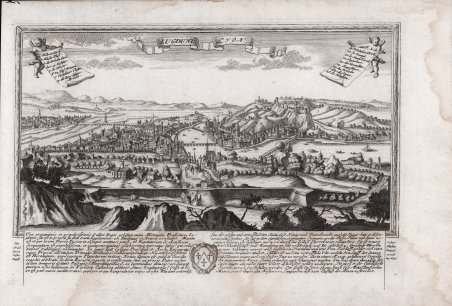Bella e rara veduta panoramica della città delineata sulla scia della più grandi vedute disegnate da Fredrich Bernhard Werner e pubblicata ad Augsburg dagli eredi dell’editore Jeremias Wolff (1663-1724), Georg Balthasar Probst (1673-1750) – suo genero – e il suo successore, il figlio Johann Friedrich (1719-1781). Werner, nato a Reichenau, fu disegnatore, incisore, ingegnere e scenografo; durante la sua intensa vita viaggiò a lungo in vari stati europei prima in qualità di soldato poi come semplice viaggiatore, realizzando numerosi disegni dei luoghi visitati. Dopo aver trascorso un periodo di studio ad Augsburg collaborando con l’incisore K. Remshard, nel 1730 egli intraprese un viaggio in Italia, visitando molte città della penisola, per poi diventare ingegnere e scenografo del re di Prussia. La sua vasta produzione comprende una molteplicità di lavori dedicati a luoghi e città di vari paesi europei – Polonia, Olanda, Francia, Italia – soffermandosi in particolare sulla sua patria, alla quale sono dedicate le immagini della “Scenografia urbium Silesiae”, edita dagli eredi di Johann Baptist Homann a Norimberga. Werner può essere considerato uno dei più prolifici disegnatori della sua generazione, uno degli ultimi grandi personaggi che nel corso del Settecento si dedicano alla realizzazione del ritratto di città rappresentando la struttura urbana nella sua interezza, nel solco di una tradizione ormai secolare; nel corso del secolo le logiche che si affermeranno saranno invece da un lato quelle che frantumeranno la città in più immagini, dall’altro quelle che porteranno alla definitiva affermazione della topografia scientifica. Le immagini del Werner costituiscono un modello per la realizzazione di alcune altre vedute edite in Europa. Tra queste vanno ricordate quella dell’editore viennese Christofer Haffner (1668-1754), attivo probabilmente tra il 1720 e il 1750, e quelle di Johann Christian Leopold (1699-1755). Il Leopold, era un modesto incisore ed editore di Augsburg; la sua serie di vedute di città, da cui questa incisione è tratta, venne pubblicata con pochissima tiratura, rendendo quindi le opere particolarmente rare. Incisione in rame, in ottimo stato di conservazione. Beautiful and rare panoramic view of the city sketched in the wake of the greatest views drawn by Fredrich Bernhard Werner and published in Augsburg by the heirs of publisher Jeremias Wolff (1663-1724), Georg Balthasar Probst (1673-1750) - his son-in-law- and his successor, his son Johann Friedrich (1719-1781). Werner, born in Reichenau, was a draughtsman, engraver, engineer and stage designer; during his busy life he traveled extensively in various European states first as a soldier then as a simple traveler, producing numerous drawings of the places he visited. After spending a period of study in Augsburg working with engraver K. Remshard, he undertook a trip to Italy in 1730, visiting many cities on the peninsula, later becoming engineer and set designer to the King of Prussia. His vast output includes a multiplicity of works devoted to places and cities in various European countries - Poland, Holland, France, Italy - dwelling particularly on his homeland, to which the images of the "Scenografia urbium Silesiae", published by the heirs of Johann Baptist Homann in Nuremberg, are dedicated. Werner can be considered one of the most prolific draughtsmen of his generation, one of the last great figures during the eighteenth century to devote himself to the creation of the city portrait by depicting the urban structure in its entirety, in the wake of a tradition that was now centuries old; in the course of the century, the logics that would assert themselves would instead be, on the one hand, those that would break the city into several images, and on the other, those that would lead to the definitive establishment of scientific topography. Werner's images provide a model for the creation of a number of other views published in Europe. These include those of the Viennese publisher Christofer Haffner (1668-1754), active probably between 1720 and 1750, and those of Johann Christian Leopold (1699-1755). Leopold, was a modest Augsburg engraver and publisher; his series of city views, from which this engraving is taken, was published with very few print runs, thus making the works particularly rare. Copperplate engraving, in very good condition. Cfr.


Find out how to use
Find out how to use

